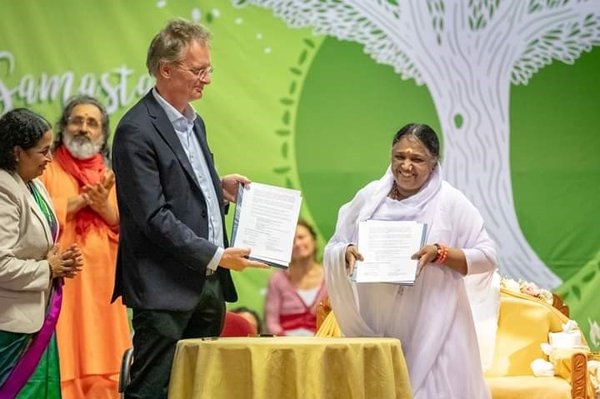The Interaction Technology (I-Tech) Master’s programme at the University of Twente is set to intensify its collaboration with Amrita Vishwa Vidyapeetham University in India. Both institutions have signed a so-called 3+2 agreement, which allows Amrita students to combine the fourth year of their Bachelor’s with the first year of the I-Tech Master’s programme at UT. The first Amrita students to come to Twente as part of this new programme are expected next September.
After their first ‘hybrid’ year, the Indian students will move on to the second year of the I-Tech Master’s programme. The EEMCS faculty already has experience with this 3+2 structure. Similar agreements with two Chinese universities, the University of Science and Technology of China (USTC) and Northwestern Polytechnical University (NPU), are already in place.

Signing Letter of Intent with Amrita, by EEMCS Dean Joost Kok
Strong reputation
“Like our Chinese partner universities, Amrita has a strong academic reputation. With this new programme, excellent students will join our exchange and Master’s programmes, meaning we will be able to offer them a wonderful opportunity”, says Interaction Technology programme director Alma Schaafstal. “UT has had an exchange agreement with Amrita for some time now, and we have already welcomed a number of Amrita students to EEMCS in recent years. We’re happy to see their numbers grow. UT is also eager to attract promising PhD students, and perhaps there are Amrita students who will want to pursue a doctorate here after finishing their Master’s.”
Common ground
Over the past few years, Schaafstal paid a number of visits to Amrita and saw many similarities with the UT. “We have gotten to know Amrita well in recent years, and we’ve already had regular staff exchanges. Like UT, Amrita is a young university with a significant social footprint and a high level of research. We offer education in similar fields, such as cybersecurity, robotics, interaction technology and biomedical technology. I also see a lot of common ground between UT’s Shaping2030 vision and Amrita’s vision for the future. They also see themselves as a people-first university, which means that they work on concrete solutions to real, societal challenges. In doing so, they’re helping to reshape India’s educational landscape. I very much look forward to further collaboration.”
Live-in-Labs programme at Amrita
Amrita has recently set up a unique programme that brings together students and teachers in multidisciplinary teams with partners from international universities. Each team spends a few months in an Indian village, using scientific knowledge to set up projects that help improve the local quality of life. In the future, UT students will also be able to take part in these Live-in-Labs.





